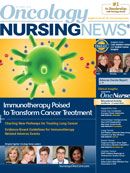Offering Durable Responses With Less Toxicity in Melanoma
The results emerging from the PD-1/PD-L1 trials mark a major step forward, noted Rajni Kannan, MN, RN, ANP, in a recent interview on the implications of this research for multiple cancers, including melanoma
Rajni Kannan, MN, RN, ANP
The results emerging from the PD-1/PD-L1 trials mark a major step forward, noted Rajni Kannan, MN, RN, ANP, in a recent interview on the implications of this research for multiple cancers, including melanoma—her specialty at the NYU Cancer Institute in New York City, where she is a nurse practitioner working mainly in clinical research as part of the Institute’s Melanoma Program.
“To see that it’s being studied in other cancers, and it’s actually showing such an amazing response in smokers who have lung cancer, is something we haven’t seen—to actually have a treatment other than chemotherapy that might work in lung cancer.”
Nivolumab is being studied in the melanoma setting at her clinic. “We call it the drug of ‘itises’— because it can trigger any ‘itis,’ but, in fact, most patients are tolerating it very, very well,” Kannan explained.
She said they are not seeing the side effects originally reported in the initial studies, but just mild changes in colitis and dermatitis, for example. “There is a higher risk for pneumonitis, but we haven’t really seen a lot of toxicities,” she added.
In fact, she noted, they have been seeing less toxicity and better responses with nivolumab than with ipilimumab, the FDA-approved immunotherapy for patients with metastatic melanoma . Her institution is participating in a phase II melanoma trial of both agents used in combination that is currently recruiting participants.
For nurses working with these immunotherapies, Kannan said it is important to have a basic understanding of immunology, because the immune system is involved in so many aspects of the body—from bowel function to temperature control.
“It’s really important to understand the way the immune system works, in order to understand the side effects of all these different new therapies that are out there.”
Patients should be advised to contact their clinician with any changes, no matter how small, she continued. “Early intervention is the best way to keep these side effects from getting worse and to avoid hospitalizations or discontinuation of therapy.”
Kannan said that not only are the responses to these new therapies dramatic, they also appear to be more durable when compared with chemotherapy, even though it may take longer for the patient to respond to the drug.
A champion of clinical trials, Kannan said that it is important for nurses to encourage patients to participate in them and help them to understand that these trials are not meant for “guinea pigs.” Rather, she said, “they are actually taking standard of care treatments and making them better for patients.”





